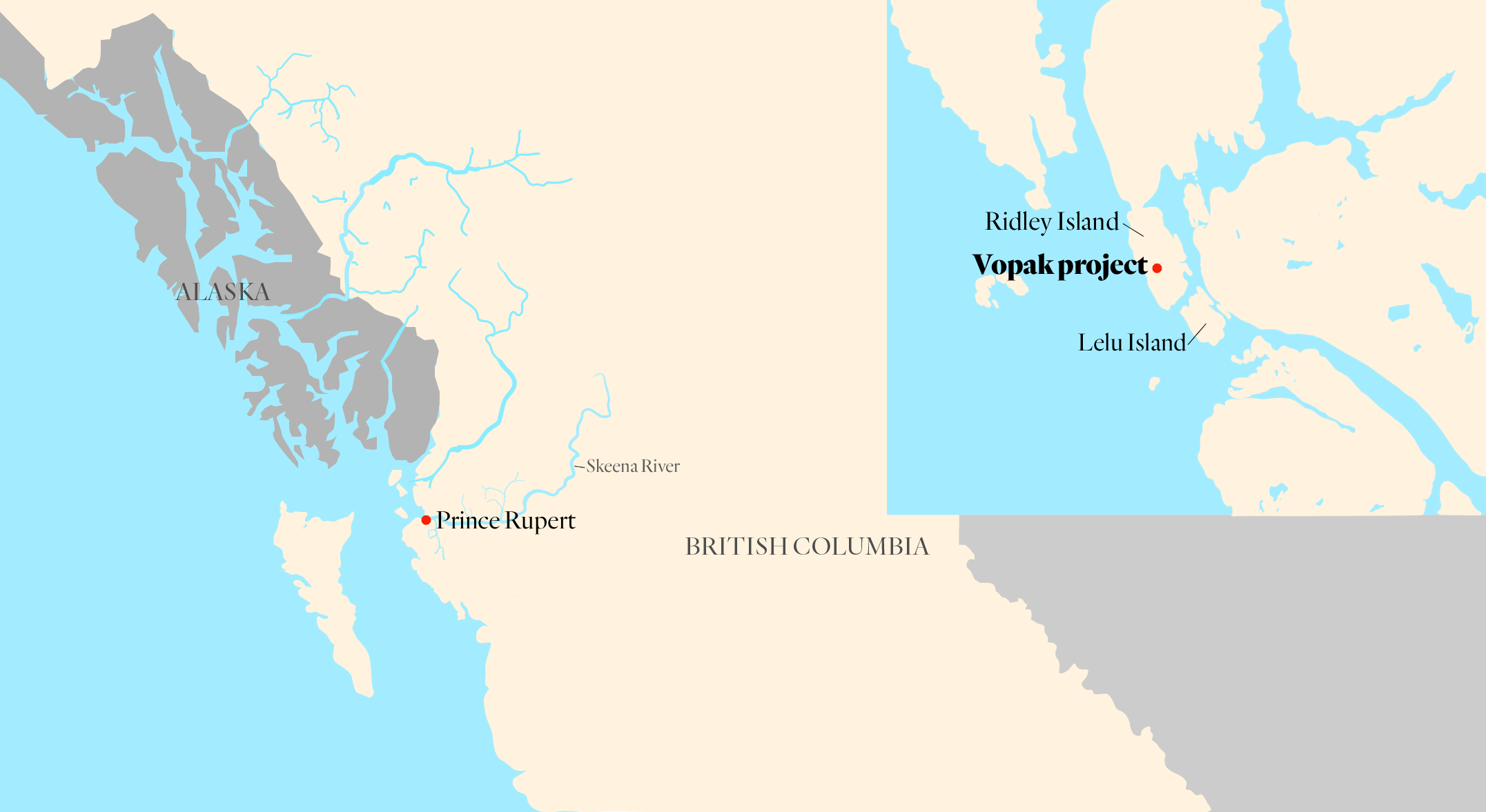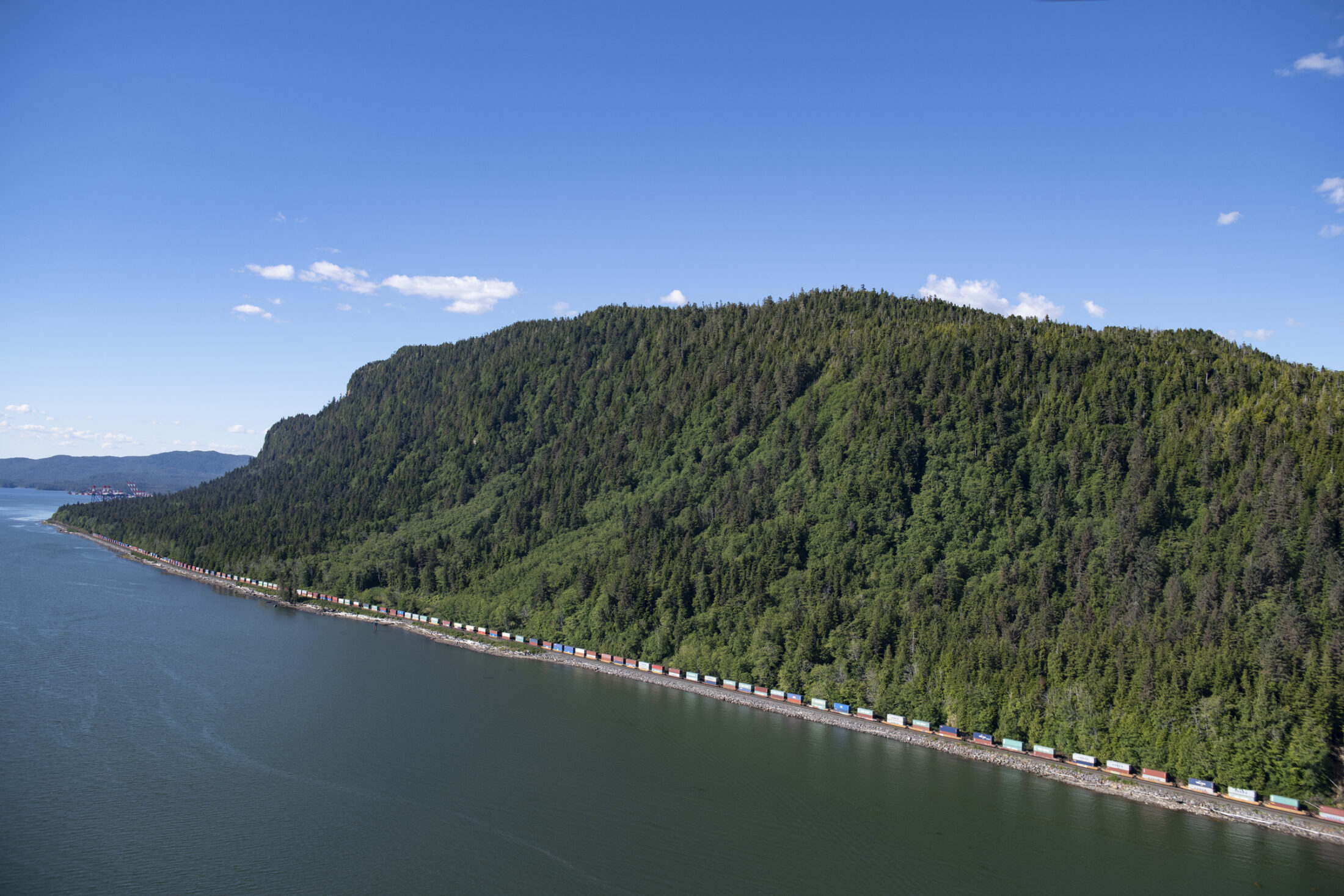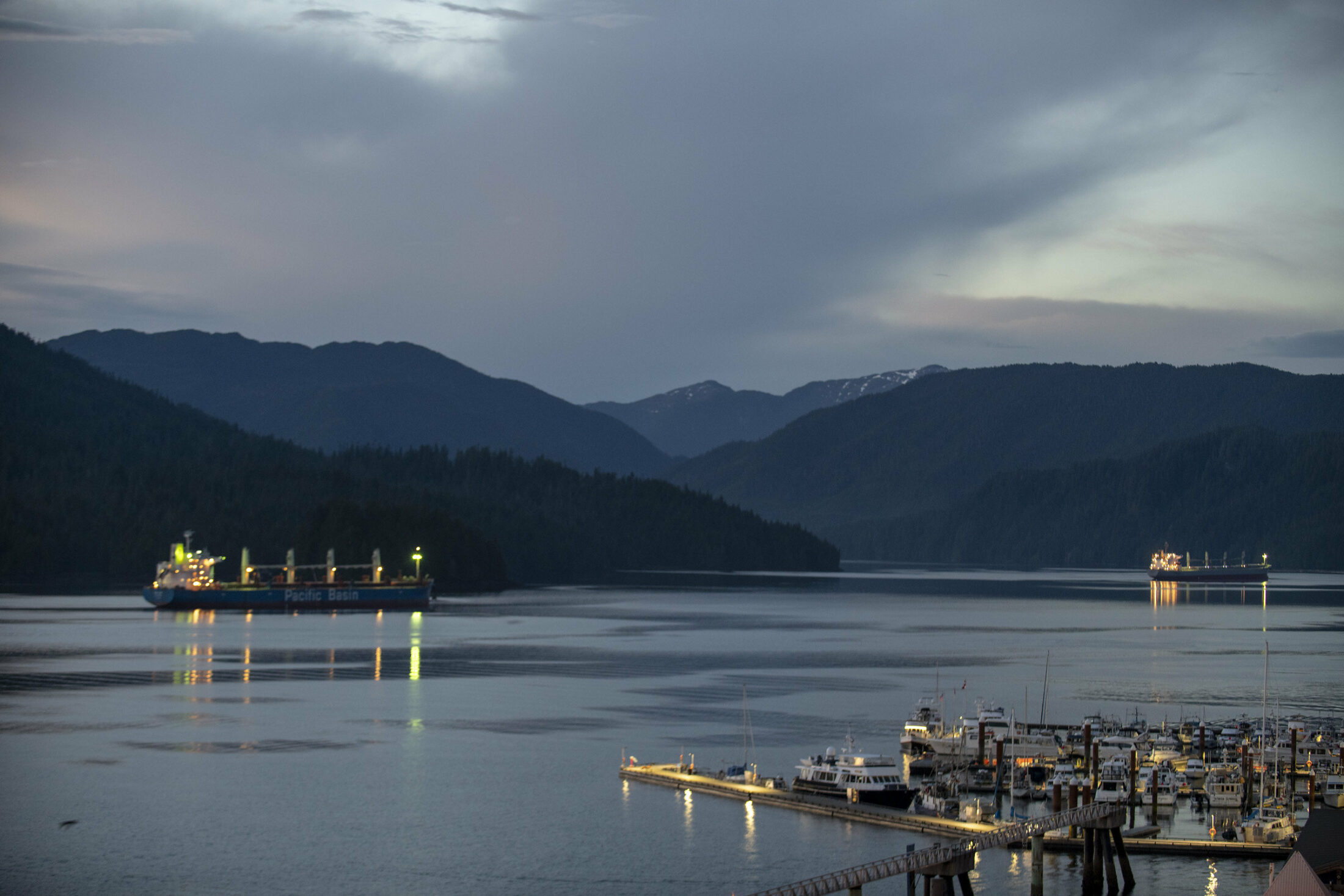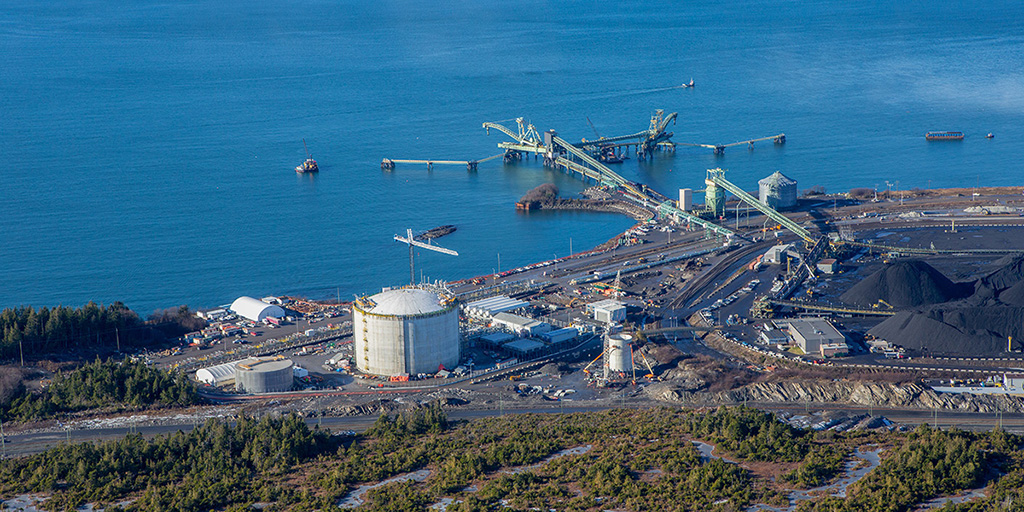
Rocky Mountain coal mine in Alberta takes next step to expansion
In Alberta, a massive open-pit coal mine near Jasper National Park is hoping to expand...
As Vopak Development Canada’s proposed fuel storage facility and export terminal near Prince Rupert, B.C., enters its final public comment period, environmental groups say the project fails to address risks associated with marine and rail transport.
If approved, the Vopak Pacific Canada facility would bring up to 240 rail cars carrying fuels like diesel, propane, methanol and gasoline through northwest B.C. every day. The fuels would be shipped on the CN rail network from sources in B.C. and Alberta to Ridley Island, an industrial site near Prince Rupert. The terminal would also bring up to 171 tankers to the Skeena River estuary annually.
“Vopak brings the risk of a spill of highly toxic diesel oil and gasoline from train derailments, tanker accidents and spills at the offloading facility,” Greg Knox, executive director of SkeenaWild Conservation Trust, told The Narwhal. “Such spills are very difficult to clean up once they enter the river or marine environment.”
Retired biologist Dawn Remington with Friends of Morice-Bulkley said the project poses a risk to communities along fuel transportation routes and not enough information about how these communities will be protected has been made available to the public.
“We’re going to be a corridor for hazardous petroleum products. And if this is the case, I want it to be done safely,” Remington told The Narwhal, adding her concerns aren’t about trying to stop the project.
Remington said the Vopak project presents an opportunity to address the risks of rail transportation associated with several projects in the region, including another proposed fuel export facility and one that’s already under construction.
Vopak recently submitted its application for an environmental assessment certificate along with its report on the project’s potential environmental impacts to the B.C. Environmental Assessment Office. The public can now review and comment on those documents until Dec. 30.

A map showing the location of the proposed Vopak Pacific Canada facility on Ridley Island. Map: Carol Linnitt / The Narwhal
During the initial public comment period in 2018, members of the public and environmental groups asked that increased rail traffic associated with the Vopak project be included in the facility’s review.
And during the First Nations consultation process, each of the six nations involved flagged increased rail traffic as an important issue that should be addressed as part of the environmental assessment.
The B.C. Environmental Assessment Office said it would not include rail traffic in the assessment, deferring to Transport Canada, the federal agency responsible for regulating the rail network.
“Concerns of potential spills from train derailments are not being assessed in the environmental assessment and are being completely ignored by CN, Vopak and the provincial and federal governments despite strong public concern,” Knox said.
CN’s rail accidents have been steadily increasing, according to a 2019 Transportation Safety Board of Canada report. Last year, there were 169 accidents involving dangerous goods, like the ones that would be shipped to the Vopak facility. Eight of those accidents resulted in spills, twice as many as the previous year.

The number of CN accidents involving dangerous goods is on the rise. Photo: Transportation Safety Board / Flickr
In March, a train carrying coal and propane derailed near an elementary school east of Prince George, B.C., spilling coal into a creek and causing an emergency evacuation of the school. Other derailments in the region over the past few years have resulted in coal and wood pellets spilling into creeks and rivers.
Read more: B.C. committed to regional environmental assessments, but experts warn they might never happen
Remington has been working with communities along the rail corridor in northwest B.C. to formally request Transport Canada conduct a risk assessment of rail traffic in the region. Even though the potential for a rail accident resulting in an explosion or deadly spill is low, Remington worries a single event could have catastrophic effects.
Propane — also referred to as liquified petroleum gas — is a highly-combustible fossil fuel captured as a by-product of fracking for natural gas. More propane travelling through the region means more risk, she said.
“Risk is the probability of something happening times the severity of the consequences if it happens,” she explained. “So even if the probability is low, the consequences are enormous.”
She stressed that without knowing the risks, the communities along the rail corridor aren’t equipped to deal with an emergency should one arise. “How do you evacuate this entire town if people have no idea?”

People are worried about the increased rail traffic the proposed Vopak Pacific Canada project would bring to Prince Rupert and other communities along the route. Photo: Prince Rupert Port Authority
The concern is shared along the transportation corridor, even in towns hundreds of kilometres from the proposed Vopak facility.
In a recent public comment on the project, Jeanette Weir, from Hazelton, B.C., said the threat the export terminal poses to communities along rail lines has effectively been overlooked.
“This project is completely ignoring the communities through which an enormous increase of rail transport of explosive dangerous goods is proposed. It should not be evaluated for the sole risks at the Prince Rupert storage facility because it will affect all of us living along the rail line.”
In a document provided to First Nations outlining the potential effects of increased rail traffic, Vopak said the project would contribute to an incremental increase in the risks associated with rail transportation, including moose strikes, collisions and derailments. It also stressed that all regulations related to rail safety fall under the jurisdiction of Transport Canada.
Public requests that the environmental impacts of marine traffic be included in the projects assessment were also denied by the Environmental Assessment Office, leading to lingering concerns the project will harm marine ecosystems.
The proposed facility would include a number of holding tanks for fuel and a marine berth where tankers would be filled over 40-hour periods. Vopak would only be responsible for products during storage, unloading and loading.
For nearly 50 years, a now-shuttered pulp mill near Ridley Island discharged contaminated materials into the marine environment, much of which is now sequestered in a layer of sediment on the ocean floor — including where Vopak would provide mooring for tankers.
Although Vopak scrapped its initial plan to dredge up the contaminated sediment to make way for a permanent jetty, many worry the current plan to leave sediment — which contains highly toxic dioxins and furans as well as copper and arsenic — undisturbed is unrealistic.

An artist’s rendering of the proposed Vopak Pacific Canada facility. Photo: Vopak Canada
According to Luanne Roth, north coast campaigner for the T Buck Suzuki Environmental Foundation, the new plan was submitted after the initial public comment period, so any public concerns about the redesign have yet to be addressed.
“Before, with the big dredge, all of that contaminated sediment would have been gone from the area,” she said. Now the issue is what happens to the sediment when tankers are mooring.
“When the boats are docked, they’re docked by really powerful tugs, so there’s going to be really powerful propeller wash,” she said.
The effects of propeller wash, the movement of water by ships’ engines, on the sediment have not been studied for the Vopak project, but they were when the Pacific Northwest LNG terminal was on the books for neighbouring Lelu Island. Roth said those studies estimated five centimetres of sediment would be resuspended every day.
All of that toxic sediment would then be distributed by tides and currents within the surrounding marine ecosystem. Opposite Lelu Island, and within sight of the proposed Vopak project, is Flora Bank, which has been noted as a critical juvenile salmon habitat. Given the dramatic declines in Skeena salmon populations, the effects could be felt throughout the entire Skeena watershed.

The proposed Vopak Pacific Canada facility is close to Lelu Island (middle), which nearly became an LNG export facility, and Flora Bank (bottom right), an important juvenile salmon habitat that’s protected by a development moratorium. Photo: Prince Rupert Port Authority / Facebook
Roth said there may be solutions to the problem, but the absence of any mention of the effects of propeller wash in Vopak’s environmental effects evaluation is troubling, especially because the chemicals are known to have negative effects on human health, including increased risk of autism, cancer and diabetes.
“There’s a tremendous amount of food gathering in the Skeena estuary, so it’s a really big concern,” she said.
In an emailed statement, Vopak communications director, Stefany Cortes, told the Narwhal “the tugboat propulsion is focused higher in the water column and, therefore, is not expected to resuspend sediment during mooring.”
Roth also raised concerns about the increased marine traffic and the potential for a catastrophic spill. As The Narwhal previously reported, many of Prince Rupert’s designated anchorages are situated in water that lies atop a thin layer of mud and sediment on smooth rock. In high winds — very common during fall and winter — a ship can drag its anchor and potentially end up smashing against coastal rocks.
Even just one ship spilling its fuel, not to mention its cargo of fuel, would have catastrophic effects on the marine ecosystem.

Anchor-dragging incidents in the Prince Rupert port are common due to the weak anchoring environment and the stormy weather. Photo: Prince Rupert Port Authority
According to a T Buck Suzuki study, between 2004 and 2017, the Prince Rupert port had three times as many anchor-dragging incidents as the Port of Vancouver despite having 86 per cent less vessels. This works out to 2,360 per cent more incidents per visit.
Roth said there were 29 incidents in Prince Rupert last winter.
Earlier this year, T Buck Suzuki commissioned an independent report to assess the safety risks associated with anchoring in the Prince Rupert area. Prepared by Ivan Todorov, a master mariner and former senior officer on oil tankers, the report noted that “delaying and cancelling of the cargo operations because of adverse weather is something well implemented within the oil and gas industry.”
But Todorov added that the Vopak project should be subject to a formal risk assessment of grounding and collision incidents.
The Prince Rupert Port Authority, which is responsible for federal lands and waters in the area and is the coordinator of the environmental assessment for the proposed project, recently commissioned an independent navigational risk assessment. But when The Narwhal asked to review the document, the port said it would not make the report available to the public.
Port communications director Monika Cȏté told The Narwhal in an emailed statement that the port authority has strict policies and procedures in place for the movement and anchorage of ships coming and going from the Ridley Island Propane Export Terminal, of which Vopak is part owner, and similar policies and procedures would be implemented for the proposed facility. Those procedures include port-assigned pilots and tugboat assistance.
“Procedures vary depending on vessel, cargo and terminal they are going to, and what is required to mitigate navigational risk,” she wrote. “Vopak-specific procedures will be determined through a multi-agency effort that includes vessel simulation trials.”

Vopak Canada has a 30 per cent stake in Canada’s first propane export facility, the Ridley Island Propane Export Terminal, and is hoping to expand that interest with the proposed Vopak Pacific Canada facility. Photo: Prince Rupert Port Authority
She said it is uncommon for ships to remain at anchorage once they’re loaded. “In the very rare circumstance that a loaded vessel would move to anchorage, the tug would remain in attendance with the vessel while it is at anchor,” she wrote.
Roth said if the port is not able to prevent fully loaded ships from anchoring during storm events, Vopak could contractually refuse to fill a tanker if extreme weather was in the forecast. “That’s something we’d really like them to address,” she said.
In the new year, Vopak Development Canada will compile all of the comments received during the public comment period and submit them to the B.C. Environmental Assessment Office. The office will then consult with the province, the port authority, local First Nations, Fisheries and Oceans Canada, Transport Canada and other stakeholders to resolve any outstanding issues.
If no red flags are identified, the stakeholders will sign off on the project and a final decision will be made by provincial ministers.
Vopak projects it will start construction in late 2021.
Get the inside scoop on The Narwhal’s environment and climate reporting by signing up for our free newsletter. A $335 million funding commitment to fund...
Continue reading
In Alberta, a massive open-pit coal mine near Jasper National Park is hoping to expand...

A trade war could help remake B.C.’s food system, but will family farmers be left...

First Nations are leading efforts to make sure lake sturgeon can find a home in...
